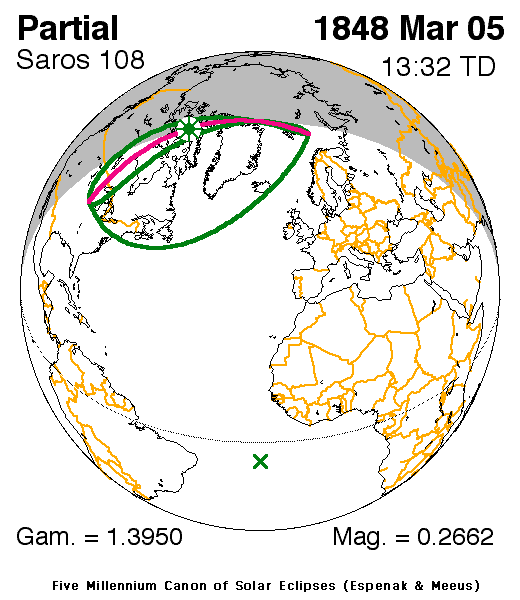|
Solar Eclipse Of April 3, 1848
A partial solar eclipse occurred at the Moon's Lunar node, descending node of orbit between Monday, April 3 and Tuesday, April 4, 1848, with a Magnitude of eclipse, magnitude of 0.5834. A solar eclipse occurs when the Moon passes between Earth and the Sun, thereby totally or partly obscuring the image of the Sun for a viewer on Earth. A partial solar eclipse occurs in the polar regions of the Earth when the center of the Moon's shadow misses the Earth. This eclipse was the second of four partial solar eclipses in 1848, with the others occurring on March 5, August 28 and September 27. Description The eclipse was visible in the Pacific Ocean and included the northeast and northwestern Antarctica especially a part of the west of the Antarctic Peninsula. The eclipse started at sunrise offshore from Antarctica where the Indian and the Pacific Ocean divide and ended at sunset in the peninsula and offshore from Chile. It showed about up to 15-30% obscuration in northern Antarctica with ... [...More Info...] [...Related Items...] OR: [Wikipedia] [Google] [Baidu] |
Solar Eclipse
A solar eclipse occurs when the Moon passes between Earth and the Sun, thereby obscuring the view of the Sun from a small part of Earth, totally or partially. Such an alignment occurs approximately every six months, during the eclipse season in its new moon phase, when the Moon's orbital plane is closest to Ecliptic, the plane of Earth's orbit. In a total eclipse, the disk of the Sun is fully obscured by the Moon. In #Types, partial and annular eclipses, only part of the Sun is obscured. Unlike a lunar eclipse, which may be viewed from anywhere on the night side of Earth, a solar eclipse can only be viewed from a relatively small area of the world. As such, although total solar eclipses occur somewhere on Earth every 18 months on average, they recur at any given place only once every 360 to 410 years. If the Moon were in a perfectly circular orbit and in the same orbital plane as Earth, there would be total solar eclipses once a month, at every new moon. Instead, because the Mo ... [...More Info...] [...Related Items...] OR: [Wikipedia] [Google] [Baidu] |

